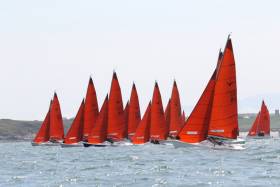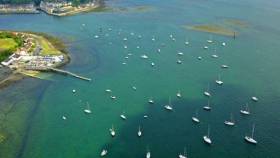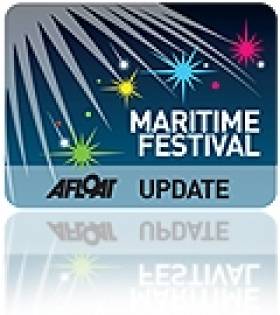Displaying items by tag: Killyleagh
Squib Keelboats Ready for Killyleagh Irish Championships
Get ready for the most open Irish Squib championship in many years from 4-6 August at Killyleagh, on Strangford Lough sponsored by EBANISTI Cabinetmakers and Batt Sails. The National Squib Class of keelboats have already had three major championships this year.
The Irish Northern Championship held in May at Cultra, was hosted by the Royal North of Ireland Y.C. The winner was the boat which won last year’s National championship, 'Fagin' which now has new owners, Gordon Patterson and Ross Nolan from the host club. This pair previously owned ‘Quickstep III’ with which they won many championships. They have had their eyes on ‘Fagin’ for many years.
At the UK National championships at Holyhead, three Irish boats competed, with Noel Colclough and Vincent Delany in 'Periquin' from the Dun Laoghaire Motor Yacht Club taking the highest Irish place, finishing in a lowly 19th place in the 43 boat fleet. The joint winner of that championship, who only lost the title on count back, was Dick Batt crewed by Suttonian Pamela Phelan. Remarkably, they sail boat No 11, which is called 'Squib' as she was the first production boat from the Oliver Lee workshops in 1968. The Volvo Dun Laoghaire Regatta was won by 'Periquin' who was pushed very hard by Peter Wallace in ‘Toy for the Boys' also from Royal North of Ireland Y.C..
No championship preview would be complete without a mention for 'Aficionado ' sailed by Olympian John Driscoll and David Cagney from Howth, who always seem to have the speed and ability, if not always the results.
The patterns above show that the home boats always have an advantage. Will any of the Killyleagh Squibs have the ability to win? Possibly not this year.
The turn out of Squibs at Killyleagh is likely to be impressive, with the fleet split between three sailmakers- Batt sails which excel in lighter and heavier winds, Hyde sails which are unbeatable in mid-strength winds, and the as yet untested Olympic Sails from Kinsale.
Two people were rescued from the water earlier this evening in Killyleagh, Strangford Lough, Northern Ireland after falling overboard from a dinghy.
A member of the public made a 999 call to the UK Coastguard at 7.00pm to report that they could hear shouts for help coming from the water at Killyleagh. Portaferry Coastguard Rescue Team and the Portaferry RNLI Lifeboat made their way to the incident.
Only minutes before the RNLI arrived, the Killyleagh Yacht Club Rescue boat reached the scene and found two people in the water. One person had fallen from the dinghy and was found clinging to the stern of moored vessel and the other person was clinging to a dinghy that was drifting out to sea.
The two casualties were taken to the Killyleagh Yacht Club, where one was treated for hypothermia by the Northern Ireland Ambulance Service.
Strangford Celebrates Maritime Festival
Plus there's family friendly entertainment for everyone: have-a-go canoeing, boat tours including Sea Safaris and Underwater Wonders LIVE, a seaweed squelch, moth mornings, literary and archeology trails, art exhibitions, fabulous local food, music on the promenade to name but a few and, of course, lots of rich natural and built heritage to explore.
Visit www.strangfordlough.org for a detailed programme of festival events. Some events are free and others require ticket purchase. Tickets can be booked at local Tourist Information Centres; Portaferry - Tel: 028 4272 9882; Ards - Tel: 028 91826846; Downpatrick - Tel: 028 44612233. Also Strangford Lough and Lecale Partnership, Portaferry, (Mon to Fri only). T. 028 427 29005.
The Celebrate Strangford Lough Festival will present the Lough's amazing heritage through activities and events involving many of the people who work and live here. It is organised by the Strangford Lough and Lecale Partnership and funded by the Heritage Lottery Fund, Down District Council and Ards Borough Council, with support from the Northern Ireland Environment Agency and the National Trust.
Strangford Lough Gears up for June Sailing Weekend
As local boats on the Lough launch their boats in preparation for the 2011 sailing season, entries continue to come in from all around the UK and Ireland, making the 2011 event the most exciting ever. From big names in big boats to the small two person Squib class, there will be fantastic racing for everyone on the championship courses around the stunning waters of Strangford Lough. Whether you wish to sail in IRC, One-design, PY or a more relaxed 2-Sail we have a class to suit.
Competitors can look forward to plenty of prizes and a lot of fun. Whilst Principal Race Officer, David Young, puts all his efforts into making sure the on the water activities run smoothly, a dedicated team will be making sure that off the water competitors, crews and visitors will not be short of entertainment. Based in Killyleagh Yacht Club, an extensive programme of bands and live acts will ensure everybody participating has a great weekend as well.
For more information on this event please visit www.slrw.org
Killyleagh Yacht Club
Situated on the west shore of Strangford Lough, the Club has a good landing pontoon which gives easy access to all local facilities. However, there is no overnight berthing at the pontoon. Members cruisers are moored in 2–4 metres SSW of Town Rock. Visitors are welcome to anchor outside the moorings. Club members race Cruisers, Flying Fifteens, Lightnings and dinghies. KYC is the most centrally positioned Yacht Club.
Killyleagh Yacht Club, 22 Cuan Beach, Kilyleagh, Co Down BT30 9OU. Email: [email protected], tel: 028 4482 8250
Commodore: Dr David Bain
Hon Secretary: Gordon Galloway, tel: 028 925 87200
Sailing Secretary: David Thompson, tel: 028 926 79710
Membership Secretary: Raymond Beattie, tel: 028 448 31187
Have we got your club details? Click here to get involved
































































